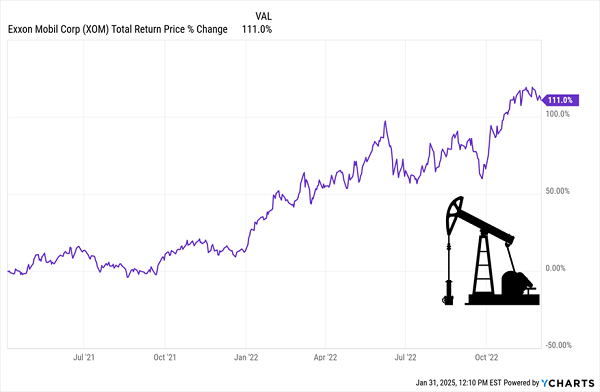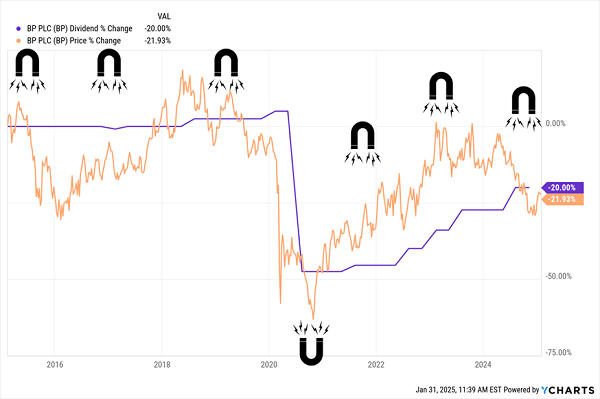We are—unequivocally—bullish on the US economy. We’re also big fans of the 6.1% dividend we’re going to discuss below, which trades for less than half its annual sales.
That’s pretty much the opposite of the nosebleed 26 times sales (and 0.03% yield—not a typo!) over at NVIDIA (NASDAQ:), even after last week’s panic over Chinese AI chatbot DeepSeek.
US Stocks Are Wealth-Building Machines …
The fact is, it’s easy to be bullish on the US these days, with the country’s economy leading (and in many cases lapping!) those of other countries.
The IMF, for example, sees the US economy growing 2.7% in 2025, tops in the G7 and nearly triple the forecast 1% growth in the Eurozone.
What’s more, the US accounted for 26% of global GDP in 2024, according to Visual Capitalist. That’s despite the fact that we only account for a little over 4% of the world’s population.
The productivity, dynamism and sheer power of the US economy are marvels—and something we should all be proud of.
… But They’re Not Invulnerable
But here’s the thing: The ‘s valuation is overstretched (to say the least!). The 2023 and 2024 bull runs have left the S&P 500 trading at a nosebleed 26 times earnings as I write this. The ? A ridiculous 33 times.
With numbers like that, you could be looking at a “lost decade” if you’re sitting in an index fund like the popular (SPY).
Population growth won’t save us, either. According to the Congressional Budget Office, our numbers will grow just 0.6% a year on average from 2024 to 2034. Look out further and that figure drops sharply, to a mere 0.2% annually from 2045 to 2054.
And we have tighter immigration policies coming. Not to mention tariffs, which threaten to slow economic growth and throttle up inflation.
A Stock Picker’s Market Is Here—With a Global Flare
The point I’m making is that when it comes to stocks, those who sit in an index fund are in for a shock.
The winners in the next decade will be those who make timely moves into (and out of) individual stocks. And if you focus on top-quality dividend stocks, you give yourself two extra advantages:
- Big yields, which we can use to fund our lives, no matter what the market does.
- Dividend growth, which, as we’ll see in a sec, is the No. 1 driver of stock gains.
Don’t get me wrong. I’m still a big believer in America. But we contrarian income investors always follow the data, and what it’s telling us is clear: Now is the time to diversify a little beyond America’s borders.
It’s just the safe thing to do.
Plus there are simply more global stocks in the bargain bin after this massive US-market run-up, like the 6.1%-yielder (with a growing payout) we’ll get into momentarily.
The Sun Never Sets on BP’s Empire
Here’s another edge we have as US investors: Because the US market is so dynamic, everyone wants to list here. Which means we can buy big international dividend payers on the NYSE.
Which brings me to the stock we’re going to delve into today: BP (NYSE:)), the British energy giant, a holding of my Contrarian Income Report advisory. BP yields 6.1%, trades on the NYSE and even pays dividends in US funds.
It’s the same as buying a US-based producer like Exxon Mobil (NYSE:) but you’re getting a much higher dividend—XOM yields just 3.7%.
(XOM, I should mention, is a former CIR holding, which we bought back in April 2021, at the depths of the pandemic lockdowns, when it yielded a stout 6.3%, pretty much what BP pays today. We sold a little over a year and a half later, in December 2022, taking a 111% total return with us.)
We Bought BP’s American Cousin When It Yielded 6% (and It Soared)

Back to BP, whose mix we like better than that of XOM today, with its strong base in the US, through its presence in important shale areas, like the Permian and Eagle Ford. That’s complemented by offshore fields in places like its Clair oilfield, offshore Scotland and production facilities, like its LNG operation in Indonesia.
BP has been around forever (more than a century), and like the old British Empire, the sun never sets on its 61-country operation. It was the first company to pull oil out of the ground in the Middle East (in 1908) and opened the first refinery in the region (in 1912).
Beyond Oil and Gas
BP also deals in wind power, hydrogen and carbon capture; owns thousands of miles of pipelines; has commercial operations, such as convenience and retail fuel stations, Castrol lubricants and EV charging; trades oil, gas, and renewable and non-renewable power; and even has a bioenergy business.
In other words, management has smartly positioned BP as a leader in the energy transition and in the fossil fuels that will still play an important role in the global economy for years to come.
Which brings us back to that 6.1% dividend.
The company cut its payout by 50% in 2020 and shares were chopped in half, as well. That’s the result of the “Dividend Magnet,” which long-time readers will recognize as the tendency for share prices to track dividend hikes (and cuts!).
Since then, though, the giant has recovered. Sales doubled between 2020 and 2023, and the firm is solidly profitable again.
The “payout penance” continues for BP, with four hikes in the books since its infamous cut. This reminds us that CFOs are like carpenters—they measure twice and cut the dividend just once if they can help it. So far, so good. BP’s dividend sits 50% higher than after the cut. That’s still off its peak but trending positively.
BP Cuts a Path From the Dividend Doghouse

The fact that the British oil giant pays out just 36% of its last 12 months of free cash flow (FCF)—well below my 50% “safety limit”—is another indication that management got it right here.
Even so, income scars (and memories of them) are slow to heal. BP trades for only 8.4-times forward earnings and 0.45-times trailing sales today. Contrast that with Exxon, which trades for 1.4-times sales and 14-times forward earnings.
This sad pup will soon be readopted by income-hungry investors, especially if 10-year Treasury rates continue to keep bouncing off their “5% ceiling,” as I expect. That suggests long rates are high enough to keep inflation trending down—putting lower rates on the table in the future.
All of this leaves us in a pretty sweet spot with BP: collecting a growing dividend set to pull the price higher, along with a 6.1% yield. And thanks to the stock’s bargain valuation, we’re getting some nice downside insulation here (always appreciated in the volatile oil business) and a shot at strong upside, too.
And it’s all underpinned by the British giant’s exposure to the still-growing US economy and the undervalued global one, too.
Disclosure: Brett Owens and Michael Foster are contrarian income investors who look for undervalued stocks/funds across the U.S. markets. Click here to learn how to profit from their strategies in the latest report, “7 Great Dividend Growth Stocks for a Secure Retirement.”
#Sun #Sets #Cheap #Dividend


